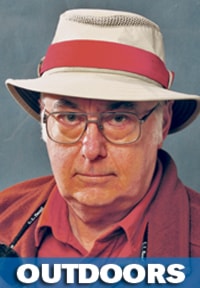For several days, the old hunter in me was smelling gunpowder in the air, then the first frost warning of the fall for Aug. 23 verified that it all wasn’t just self-delusion.
Face it — summer’s gone. It took forever to get here and was intense for a while, but it’s vamoosing in a hurry.
Outdoors people are starting to move into their fall-winter modes that are a little angrier than usual. Opposition is mounting to a proposed gravel pit operation at the headwaters of the North Raven River, Alberta’s top trout stream, and some opponents are suggesting there may be too close a connection between the proponents and their supposedly independent consultants.
The Draft Fish Stocking Policy for Alberta and lack of progress on shortening and simplifying the regulations have really struck a nerve. Anger and frustration oozes from the measured tones of Dr. Darryl Smith, Fish Committee chairman of the Alberta Fish and Game Association in his report to the executive at their Aug. 15 meeting at Narrow Lake:
“… Drafts, discussions and presentations at this stage continue to reflect a narrow internal ideology that is not reflective of stakeholders’ concerns.”
“ … Water withdrawals for fracking on the east slopes is essentially a free for all. …”
There is widespread sense from anglers and conservationists that they have had all they are going to take in terms of blame and constant calls for more studies on what to do about the threatened status in Alberta of the bull trout, our provincial fish, and the west slope cutthroat trout, both native fish.
Neither the government nor the resource extraction industries want to accept that it has long been established that the perilous plight of both species is caused by the environmental destruction our government allows the big oil and gas, mining and forestry to get away with.
What they want is more time to destroy more, so they call for more studies.
But now the AFGA and other angler conservationists are saying flatly that the time for studies is over and the time for remedial action is on. Maybe the feds will have to step in here to get something done to save these fish species, just as they have with our all-but-extinct sage grouse.
Readers have been weighing in on the last effective Alberta fish stocking efforts. The Ram Rivers, which were stocked with west slope cutthroats in the late 1950s, have been fishing so well that every angler in Alberta seems to be there, including too many tearing up the terrain down in the canyons where formerly only hiking and climbing anglers went.
Friend Ken Short reports that a little bit of me was out on the Rams this summer when spouse Denise hooked a cutt large and heavy enough to escape by straightening the hook on one of my LeTort Hoppers with the red rubber “kickers.”
Then, from 350 km away, I participated in daughter-in-law, Darlene, taking her first trout, a rainbow (stocked in the 1930s) in Pincher Creek on one of my Short Black Boogers.
A few days earlier, son John hooked and lost a descendent of “Mulroney,” a huge, hook- jawed brown trout that hangs out in a big backwater in Prairie Creek. (I named the fish when I caught him twice in one day during a brown drake hatch years ago.) “He took my last Short Black Booger,” John moaned.
So I astonished myself by tying my first fly in five years, a Short Black Booger, as a demo for John. My hands and fingers are still strong enough, but bad vision in one eye makes it “interesting.” Then John tied a nice one while I watched. Now he has my tools, materials and instructions to tie my patterns that money can’t buy.
In May 1969, with my former brother-in-law, the late Morgan Johnson, I fished Cottonwood Creek where it flowed through the Hawk’s Nest ranch property of author Andy Russell. We were after the brown trout fish and wildlife was dribbing and drabbing into the tiny, brush-choked creek, leftovers from the thousands planted below Lundbreck Falls on the Crowsnest to make up for loss of native trout and planted rainbows to pollution and habitat destruction. Ironically, we caught nothing in Cottonwood but a small, gorgeous, west slope cutthroat each.
Cottonwood Creek empties into the Waterton River and, over the ensuing years have come stories of increasing numbers of very large brown trout in the Waterton, which was formerly rainbows only, including the Alberta record 21-pound-14-ounce brown taken in 2010. This short summer there has been a great picture whirling around in cyberspace of a golden, chunky Waterton brown said to be only 28 inches long, but estimated to weigh 12 pounds.
We need more such fish stocking and habitat initiative, imagination, action out there on the ground and in the water and fewer hours spent inside, interminably debating policies that never seem to amount to anything but calls for more research.
Bob Scammell is an award-winning columnist who lives in Red Deer. He can be reached at bscam@telusplanet.net.
